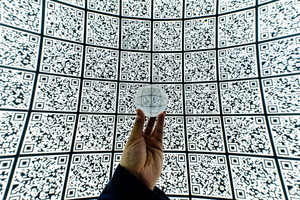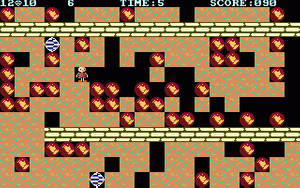
Everything you need to know about QR Codes


Was that a stretch? Maybe. Is this a dated reference? Yes, absolutely, but here’s what I’m getting at.
The original Boulder Dash game came out in 1984, and what most people don’t realize (or maybe forgot) is that the QR code was actually invented 10 years later in 1994. For those counting, that’s 25 years ago.
Over that same span of time, I’ve seen the evolution of the flip phone into smartphones, dial-up internet connection to fiber, box televisions into smart flatscreen TVs, and yes, video games that are significantly more complicated than Boulder Dash. However, you can imagine my surprise when I learned that QR codes have been around for 25 years with few disruptions to its core concept, and as you can infer from this list, few technologies in the past several decades survive this long without facing obsoletion.
Within the last several years, QR codes have made a significant comeback, and they’re not going anywhere anytime soon. However, to understand the future of this technology, it’s important to step back in time to find out when QR codes were first developed, how they became so popular, reasons for their short stall in popularity, and the advancements that brought them back into focus today.
The Development of the QR Code
The QR code (QR short for “quick response”) was born in a time where manufacturing, logistics, and retail practices were being carefully reevaluated and ultimately developed into the concepts we still practice today. In the 1980s, barcodes were the standard technology used across the aforementioned industries. However, their limitations became apparent, with the most common being they could only hold approximately 20 alphanumeric characters of information. As an example of their limitations, some production workers would have to scan up to 1,000 barcodes per day, making their work much less efficient.
Enter the late 1980s and early 1990s, when personal computers and new programs began creating better efficiencies in production lines and transportation logistics. As companies shifted from mass manufacturing of single products to more flexible production lines, manufacturing sites (particularly those working with automobiles) were in need of more robust barcodes that could handle more detailed production controls.
In 1992, Denzo Wave, at the time a subsidiary of Toyota and developers of barcode readers, was tasked to create a barcode scanner that could read more barcodes. The company tasked Masahiro Hara with the task of developing an improved barcode reader. However, he began to notice the information limitations of the barcode and sought a way to deliver more information in a smaller amount of space.
With a development team of only two other employees, Masahiro Hara set out on a year and a half journey to develop the QR code. The development period was filled with fascinating problems to solve, such as shifting from one dimensional code (used in barcodes) to two dimensional code and adding a position detection pattern (e.g. the three squares you see on the outside edges of the QR code) to improve the reading speed.
The result: a code system capable of storing approximately 7,000 figures, which is 350 times more information held within a barcode and 10 times faster than any other code system developed at the time.
QR Codes First Used in Public
While it does own the patent rights on QR codes, Denso Wave chose not to exercise those rights and subsequently released the QR code specifications for public use. This decision proved to be one of the fundamental reasons why QR codes have become as popular as they are today.
In 2002, Japanese mobile phones were released to market with built-in QR code scanners, and as a result, the adoption of QR codes quickly accelerated in Japan since almost anyone could now use this technology without any additional hardware. In an effort to connect the offline world to the online world, companies began using this technology to advertise their websites, offer coupons to customers, and provide more product information for their customers.
QR codes gained popularity in the U.S. around 2010, when reports indicated an incredible 1,200% increase in QR scanning within a 6 month period. Use of this technology quickly spread within a number of industries, including large retail companies like Best Buy and Macy’s. Companies were using QR codes to enhance the in-store customer experience, advertise websites, and build successful email marketing campaigns.
However, in a matter of a couple years, popularity for the QR code seemed to have stalled in the U.S. A number of articles, such as this one, were all calling for the death of the QR code, and looking at their reasons with retrospective lenses, we can see that some of them were validated.
Why QR Codes Lost Popularity in the U.S. for a Short Time
For a brief period, QR codes seemed to have stalled in popularity. When QR codes first gained popularity in the U.S., only a fraction of consumers owned smartphones compared to the 85% penetration rate we see today, and in addition to the lack of users, Apple and Android devices did not come with built-in or pre-loaded QR scanners like the ones we saw earlier in Japan. Combined with the fact that smartphone users would have to download and manage separate scanning apps, we began to see one of the first limitations and barriers to mass adoption for the QR code in the U.S.
Along with these limitations, the mobile experience with QR codes was hindered by a few additional factors: poor user experience compounded with slower mobile internet connections, poorly optimized marketing campaigns, and a lack of non-mobile optimized websites.
To use a QR code almost a decade ago, a user would have to pull out his/her smartphone, unlock it, find the scanner app, wait for it to open, take a picture of the QR code, and then wait for it to process the content. All of these steps, combined with mobile internet connections that would drive us crazy today (e.g. 3G), added critical seconds to the user experience.
In addition to the time spent waiting, QR codes were being placed in areas with busy or little internet connection, like subway stations, airplanes, and other public, high foot traffic areas. Websites and advertisements weren’t generally optimized for viewing on mobile devices, the screens of which were already a full 1.5 to 2.0 inches smaller than the current generation of smartphones. All of these factors complicated the user experience and ultimately stalled the adoption of QR codes in the U.S.
Comeback of the QR Codes in the U.S.
QR codes received a second wave of popularity in 2014 when Evan Spiegal, CEO of Snapchat, went to China and saw how WeChat users were utilizing QR codes. A QR code scanner was built into WeChat’s camera as a way to quickly exchange contact information, interact with certain brands, purchase food and clothing, and much more. On his way back, he began thinking of ways to integrate this technology into his own product.
In the fall of 2014, Snapchat acquired Scan, the startup behind one of the most popular QR readers on the App Store, for $54 million, and as a result, the company released Snapcodes in 2015. Snapcodes began showing up everywhere on Facebook and Twitter - even the White House had one on their website and Twitter profile picture at the time.
From there, other social media companies caught wave and began implementing similar ways to exchange information based on QR codes. In 2016, Facebook launched its Snapcode equivalent, Messenger Codes, and along the same lines, Twitter, LinkedIn, and Instagram (introduced as Nametags) all released their own version of a QR code to help quickly exchange information with their respective users.
Beyond this use case, other companies started utilizing QR codes in their own creative ways. Here are a few examples:
- For years, QR codes have been a standard on mobile boarding passes from Delta, United, American, and other airlines
- In 2017, Pinterest rolled out Pincodes, allowing Pinterest users to quickly find additional content and products from physical retail locations
- Also in 2017, Spotify launched Spotify Codes to instantly share music with other users
- From the Amazon app, Prime members can now use a QR code to save on sale items while checking out at Whole Foods
- In the world of short distance commuting, Lime, Bird, and a number of other scooter companies all use QR codes to unlock their rides
- Most e-tickets, like the ones offered through Ticketmaster, use QR codes to provide a paperless option
As you can see from this list, the QR code has come a long way from its manufacturing origins, and the number of use cases will only continue to grow. As a result, we’re seeing an exponential increase in consumer awareness for this technology, but what can we expect going forward?
The Future of QR Codes
The limitations that stalled adoption several years ago have virtually all been addressed. Popular smartphones, including the iPhone, Samsung Galaxy, and Google Pixel, now all have built-in QR scanners in their cameras. Mobile internet connections will be faster than ever with the emergence of 5G. Smartphones have larger, clearer displays, and websites are generally optimized for mobile viewing. Along with the number of applications discussed above, that leaves us wondering: what’s next?
For one, we can expect QR codes will continue to play a major part in powering the mobile experience, at least for the next several years. Juniper Research projects that the number of QR code coupons redeemed via mobile devices will reach approximately 5.3 billion by 2022. Along the same lines, mobile tickets and boarding passes will continue to gain traction as more people become more comfortable with mobile wallets and tickets.
In the field of mobile pay, we could see an increase in QR codes being used as a method of cashless payment, which is incredibly popular in China. Certain retail apps already utilize mobile payment via QR codes in conjunction with a loyalty rewards program; however, for the majority of other retailers, the growing acceptance of Apple Pay, Google Pay, and Samsung Pay could make it difficult for other mobile payment solutions to take off. Instead of mobile payment, QR codes might be better utilized at the point of sale through something like a receipt.
However, one of the most exciting growth areas for QR codes is in the field of wearable technologies, particularly those that incorporate augmented reality. Picavi manufactures a line of smart glasses for the logistics industry that incorporates a QR and barcode scanner, which allows warehouse workers to keep their hands free while also guiding them through the picking process. Vuzix, in partnership with Gemvision, offers a similar smart glass solution, which they claim reduces operational and resolution time by 25% and 40%, respectively. With the continued developments in wearable technologies and augmented reality, we may see similar applications stretch into the consumer side.
For a technology invented 25 years ago, QR codes have been through quite the fascinating journey. From its origins in manufacturing to the variety of applications being used today, this technology continues to surprise us with its utility and effectiveness in a growing number of industries. As version enhancements get deployed, we’ll see QR codes with the ability to store even more data in its code, and with the support of better infrastructure and more thoughtful implementations, who knows what we’ll be scanning in the future.
If you made it this far, thank you for reading! Check out our other blogs, reach out to us on Twitter @QuickReceiptsCo, or visit our website at www.quickreceipts.co.



